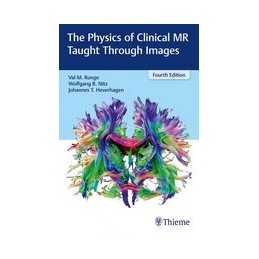Opis
The Physics of Clinical MR Taught Through Images Fourth Edition by Val Runge, Wolfgang Nitz, and Johannes Heverhagen presents a unique and highly practical approach to understanding the physics of magnetic resonance imaging. Each physics topic is described in user-friendly language and accompanied by high-quality graphics and/or images. The visually rich format provides a readily accessible tool for learning, leveraging, and mastering the powerful diagnostic capabilities of MRI. Key Features More than 700 images, anatomical drawings, clinical tables, charts, and diagrams, including magnetization curves and pulse sequencing, facilitate acquisition of highly technical content. Eight systematically organized sections cover core topics:: hardware and radiologic safety; basic image physics; basic and advanced image acquisition; flow effects; techniques specific to the brain, heart, liver, breast, and cartilage; management and reduction of artifacts; and improvements in MRI diagnostics and technologies. Cutting-edge topics including contrast-enhanced MR angiography, spectroscopy, perfusion, and advanced parallel imaging/data sparsity techniques. Discussion of groundbreaking hardware and software innovations, such as MR-PET, 7 T, interventional MR, 4D flow, CAIPIRINHA, radial acquisition, simultaneous multislice, and compressed sensing. A handy appendix provides a quick reference of acronyms, which often differ from company to company. The breadth of coverage, rich visuals, and succinct text make this manual the perfect reference for radiology residents, practicing radiologists, researchers in MR, and technologists.
Szczegóły produktu
Indeks
80336
EAN13
9781626234277
ISBN
9781626234277
Opis
Rok wydania
2018
Numer wydania
4
Oprawa
miękka foliowana
Liczba stron
336
Wymiary (mm)
152.40 x 228.60
Waga (g)
22
Contents Preface Acknowledgments Contributors Section I. Hardware 1 Components of an MR Scanner 2 MR Safety: Static Magnetic Field 3 MR Safety: Gradient Magnetic and Radiofrequency Fields 4 Radiofrequency Coils 5 Multichannel Coil Technology: Part 1 6 Multichannel Coil Technology: Part 2 7 Open MR Systems 8 Magnetic Field Effects At 3 T and Beyond 9 Mid-Field, High-Field, and Ultra-High-Field (1.5, 3, 7 T) 10 Advanced Receiver Coil Design 11 Advanced Multidimensional RF Transmission Design Section II. Basic Imaging Physics 12 Imaging Basics: k-space, Raw Data, Image Data 13 Image Resolution: Pixel and Voxel Size 14 Imaging Basics: Signal-to-Noise Ratio 15 Imaging Basics: Contrast-to-Noise Ratio 16 Signal-to-Noise Ratio versus Contrast-to-Noise Ratio 17 Signal-to-Noise Ratio in Clinical 3 T 18 Slice Orientation 19 Multislice Imaging and Concatenations 20 Number of Averages 21 Slice Thickness 22 Slice Profile 23 Slice Excitation Order (in Fast Spin Echo Imaging) 24 Field of View (Overview) 25 Field of View (Phase Encoding Direction) 26 Matrix Size: Readout 27 Matrix Size: Phase Encoding 28 Partial Fourier 29 Image Interpolation (Zero Filling) 30 Specific Absorption Rate Section III. Basic Image Acquisition 31 T1, T2, and Proton Density 32 Calculating T1 and T2 Relaxation Times (Calculated Images) 33 Spin Echo Imaging 34 Fast Spin Echo Imaging 35 Fast Spin Echo: Reduced Refocusing Angle 36 Driven-Equilibrium Fourier Transformation (DEFT) 37 Reordering: Phase Encoding 38 Magnetization Transfer 39 Half Acquisition Single-Shot Turbo Spin Echo (HASTE) 40 Spoiled Gradient Echo 41 Refocused (Steady State) Gradient Echo 42 Echo Planar Imaging 43 Inversion Recovery: Part 1 44 Inversion Recovery: Part 2 45 Fluid-Attenuated IR with Fat Saturation (FLAIR FS) 46 Fat Suppression: Spectral Saturation 47 Water Excitation, Fat Excitation 48 Fat Suppression: Short Tau Inversion Recovery (STIR) 49 Fat Suppression: Phase Cycling 50 Fat Suppression: Dixon 51 3D Imaging: Basic Principles 52 Contrast Media: Gadolinium Chelates with Extracellular Distribution 53 Contrast Media: Gd Chelates with Improved Relaxivity 54 Contrast Media: Other Agents (Non-Gadolinium) Section IV. Advanced Image Acquisition 55 Dual-Echo Steady State (DESS) 56 Balanced Gradient Echo: Part 1 57 Balanced Gradient Echo: Part 2 58 PSIF: The Backward-Running FISP 59 Constructive Interference in a Steady State (CISS) 60 TurboFLASH 61 PETRA (UTE) 62 3D Imaging: MP-RAGE 63 3D Imaging: SPACE 64 Susceptibility-Weighted Imaging 65 Volume Interpolated Breath-Hold Examination (VIBE) 66 Diffusion-Weighted Imaging 67 Multi-Shot EPI 68 Diffusion Tensor Imaging 69 Blood Oxygen Level-Dependent (BOLD) Imaging: Theory 70 Blood Oxygen Level-Dependent (BOLD) Imaging: Applications 71 Proton Spectroscopy (Theory) 72 Proton Spectroscopy (Chemical Shift Imaging) 73 Simultaneous Multislice Section V. Flow 74 Flow Effects: Fast and Slow Flow 75 Phase Imaging: Flow 76 2D Time-of-Flight MRA 77 3D Time-of-Flight MRA 78 Flip Angle, TR, MT, and Field Strength (in 3D TOF MRA) 79 Phase Contrast MRA 80 4D Flow MRI 81 Advanced Non-Contrast MRA Techniques 82 Contrast-Enhanced MRA: Basics; Renal, Abdomen 83 Contrast-Enhanced MRA: Carotid Arteries 84 Contrast-Enhanced MRA: Peripheral Circulation 85 Dynamic CE-MRA (TWIST) 86 Dynamic Susceptibility Perfusion Imaging 87 Arterial Spin Labeling Section VI. Tissue-Specific Techniques 88 Brain Segmentation, Quantitative MR Imaging 89 Cardiac Morphology 90 Cardiac Function 91 Cardiac Imaging: Myocardial Perfusion 92 Cardiac Imaging: Myocardial Viability 93 T1/T2/T2* Quantitative Parametric Mapping in the Heart 94 MR Mammography: Dynamic Imaging 95 MR Mammography: Silicone 96 Hepatic Fat Quantification 97 Hepatic Iron Quantification 98 Elastography 99 Magnetic Resonance Cholangiopancreatography (MRCP) 100 Cartilage Mapping Section VII. Artifacts, Including Those Due to Motion, and the Reduction Thereof 101 Aliasing 102 Truncation Artifacts 103 Motion: Ghosting and Smearing 104 Motion Reduction: Triggering, Gating, Navigator Echoes 105 Abdomen: Motion Correction 106 BLADE (PROPELLER) 107 TWIST VIBE 108 Radial VIBE (StarVIBE) 109 GRASP 110 Filtering Images (to Reduce Artifacts) 111 Geometric Distortion 112 Chemical Shift: Sampling Bandwidth 113 Artifacts: Magnetic Susceptibility 114 Maximizing Magnetic Susceptibility 115 Artifacts: Metal 116 Minimizing Metal Artifacts 117 Gradient Moment Nulling 118 Spatial Saturation 119 Shaped Saturation 120 Advanced Slice/Sub-Volume Shimming 121 Flow Artifacts Section VIII. Further Improving Diagnostic Quality, Technologic Innovation 122 Faster and Stronger Gradients: Part 1 123 Faster and Stronger Gradients: Part 2 124 Faster and Stronger Gradients: Part 3 125 Image Composing 126 Filtering Images (to Improve SNR) 127 Parallel Imaging: Part 1 128 Parallel Imaging: Part 2 129 CAIPIRINHA 130 Zoomed EPI 131 Compressed Sensing 132 Cardiovascular Imaging: Compressed Sensing 133 Interventional MR 134 7 T Brain 135 7 T Knee 136 Continuous Moving Table 137 Integrated Whole-Body MR-PET 138 3D Evaluation: Image Post-Processing 139 Automatic Image Alignment 140 Workflow Optimization Section IX. Appendix 141 Acronyms Index


 Dostawa
Dostawa
 Płatność
Płatność
 Zwroty
Zwroty
